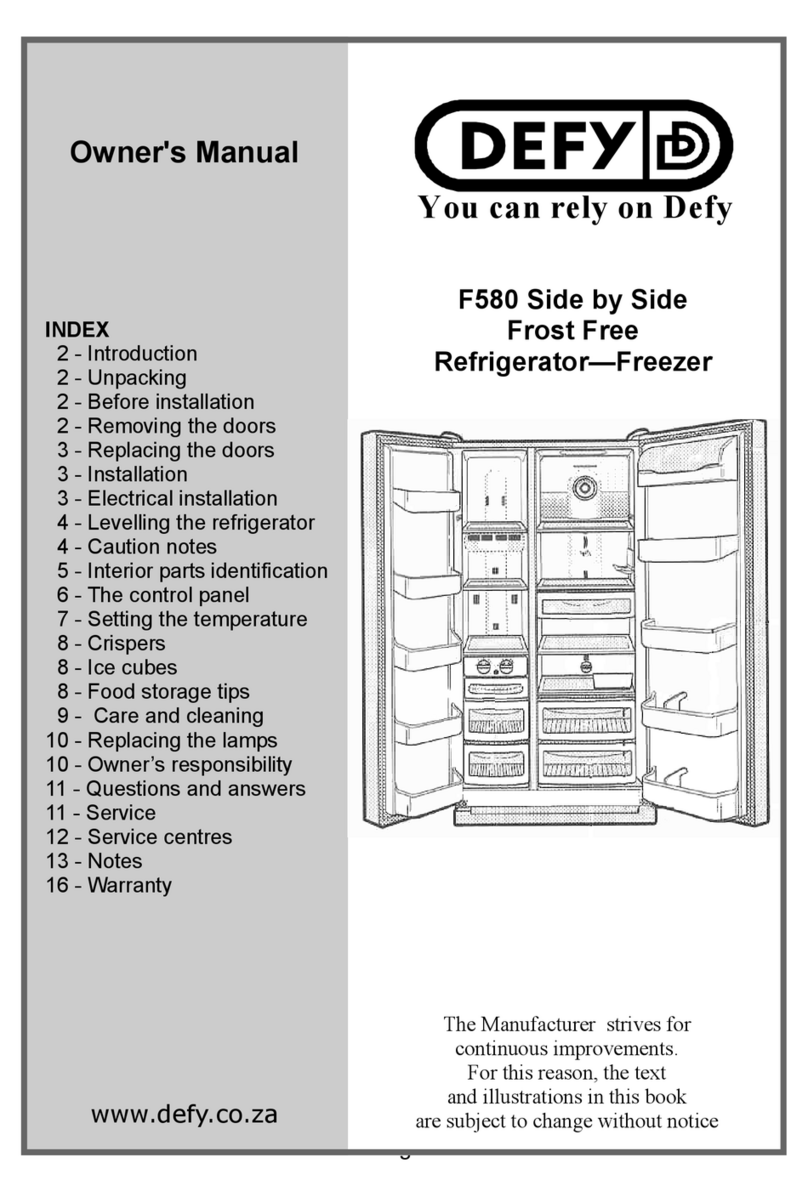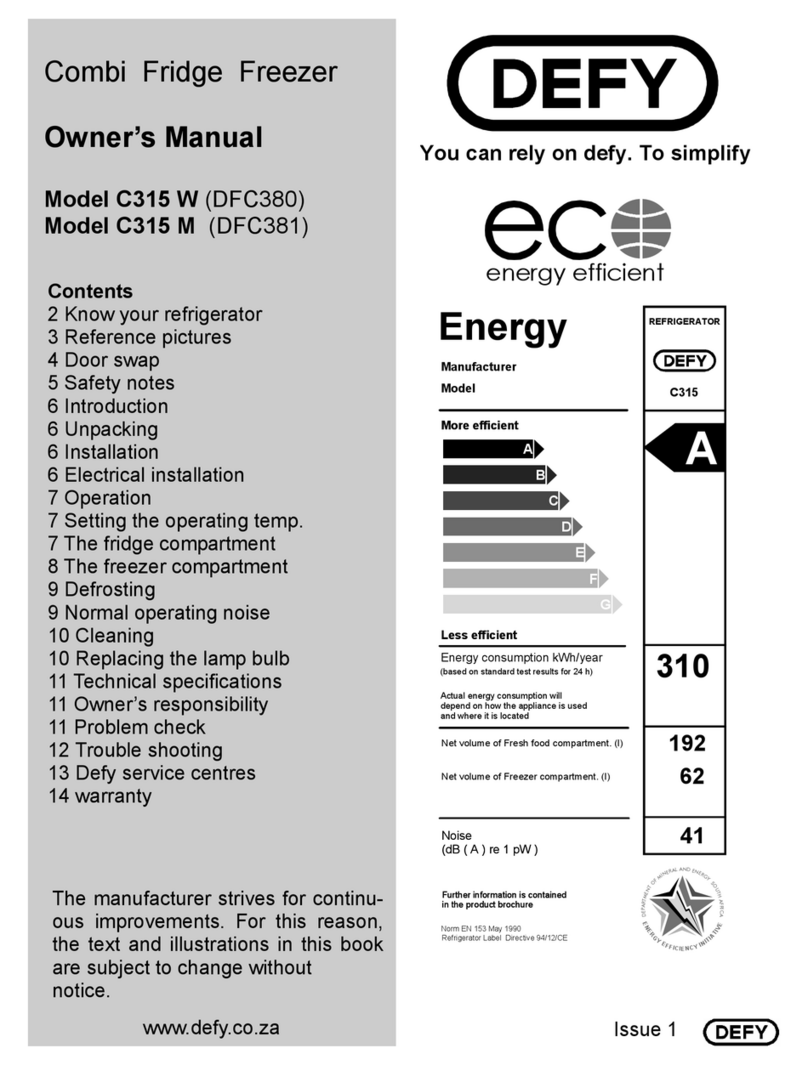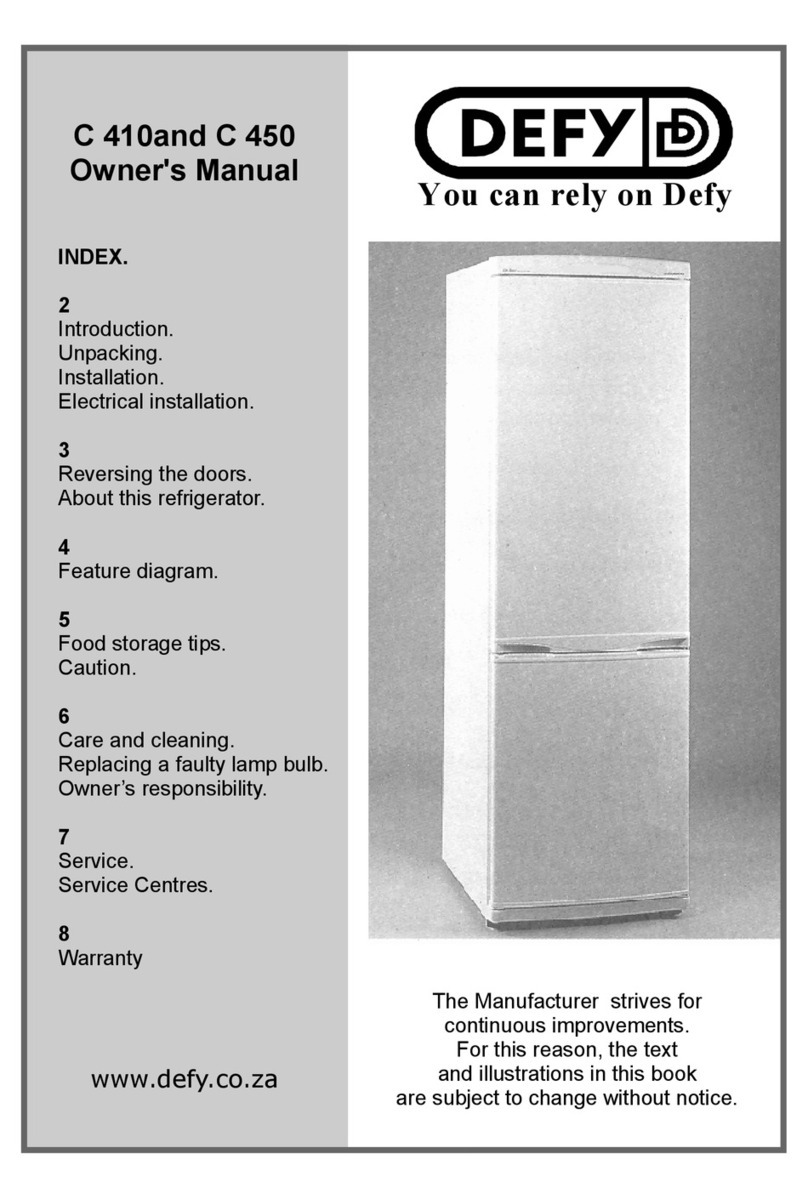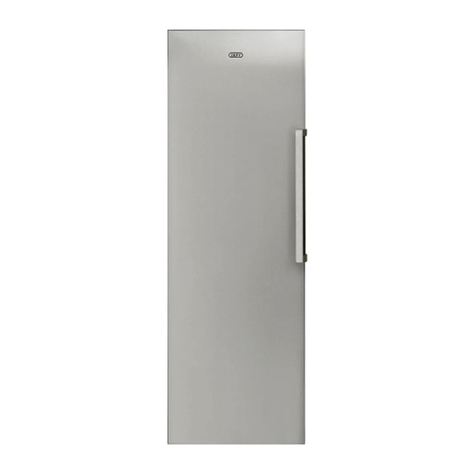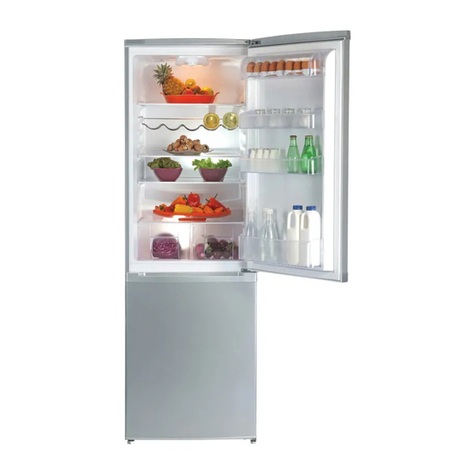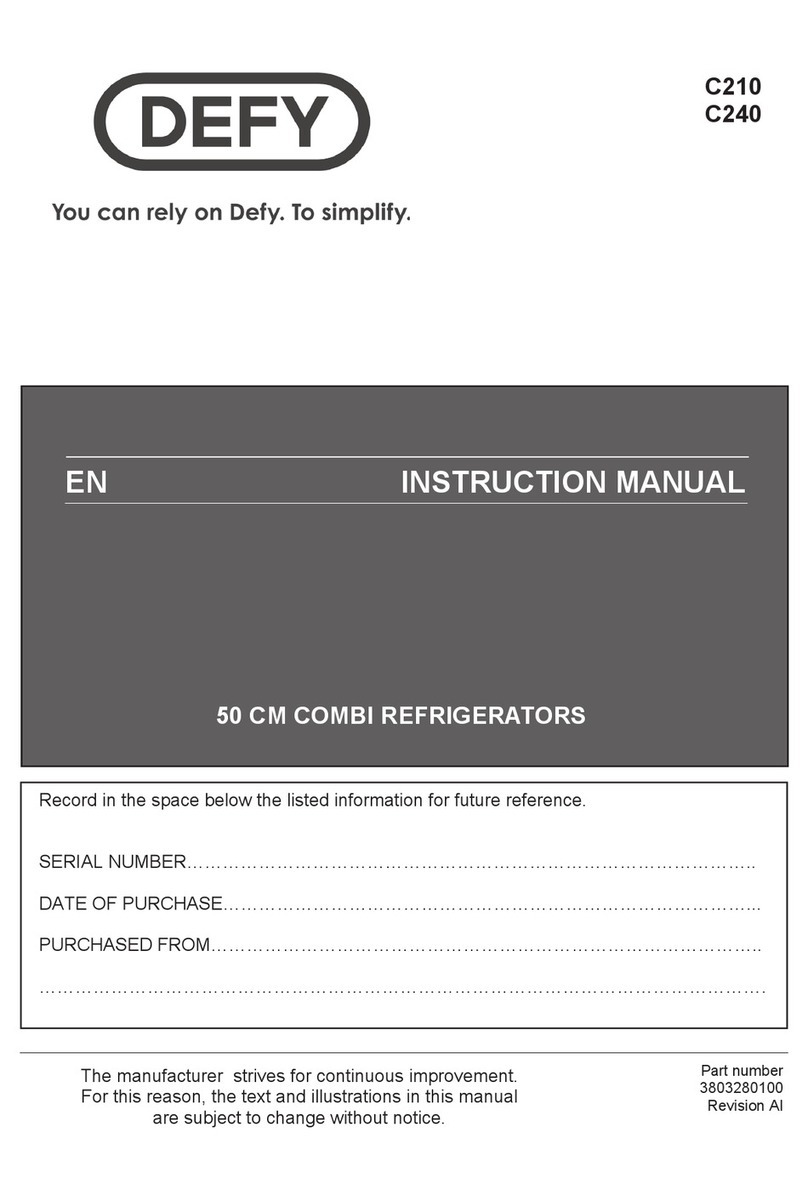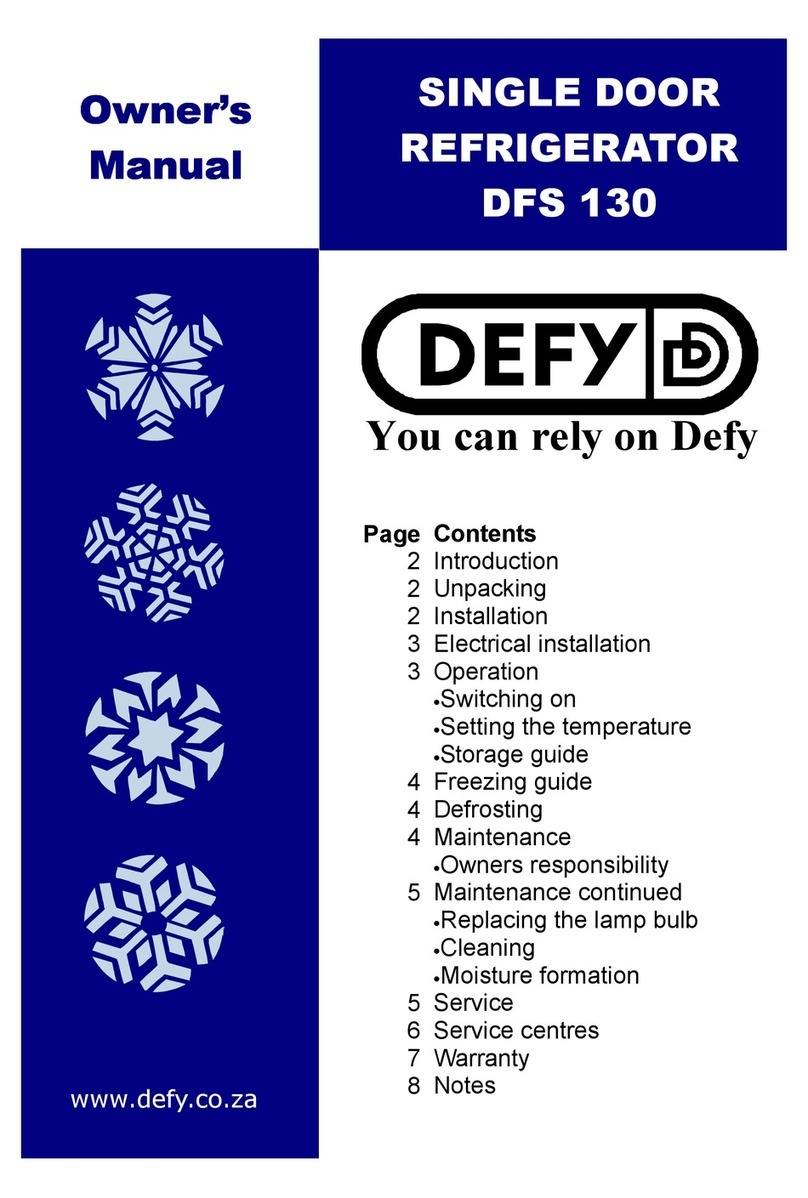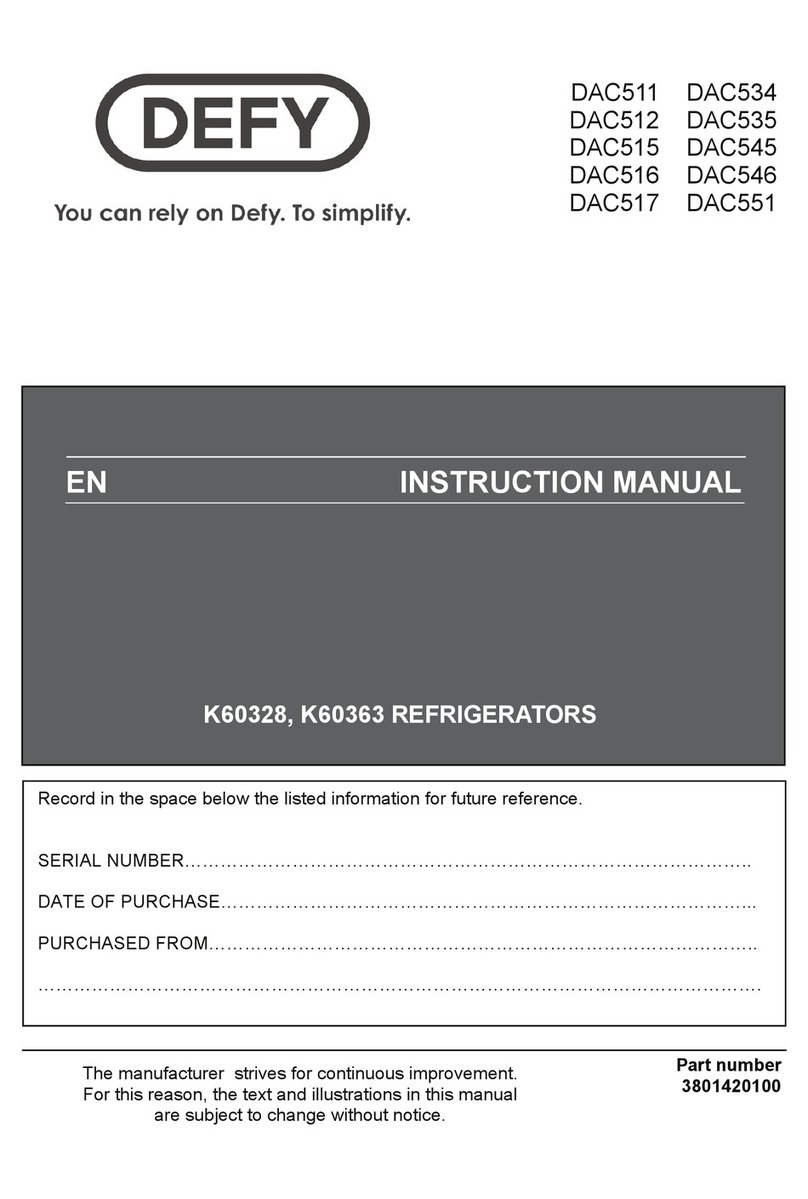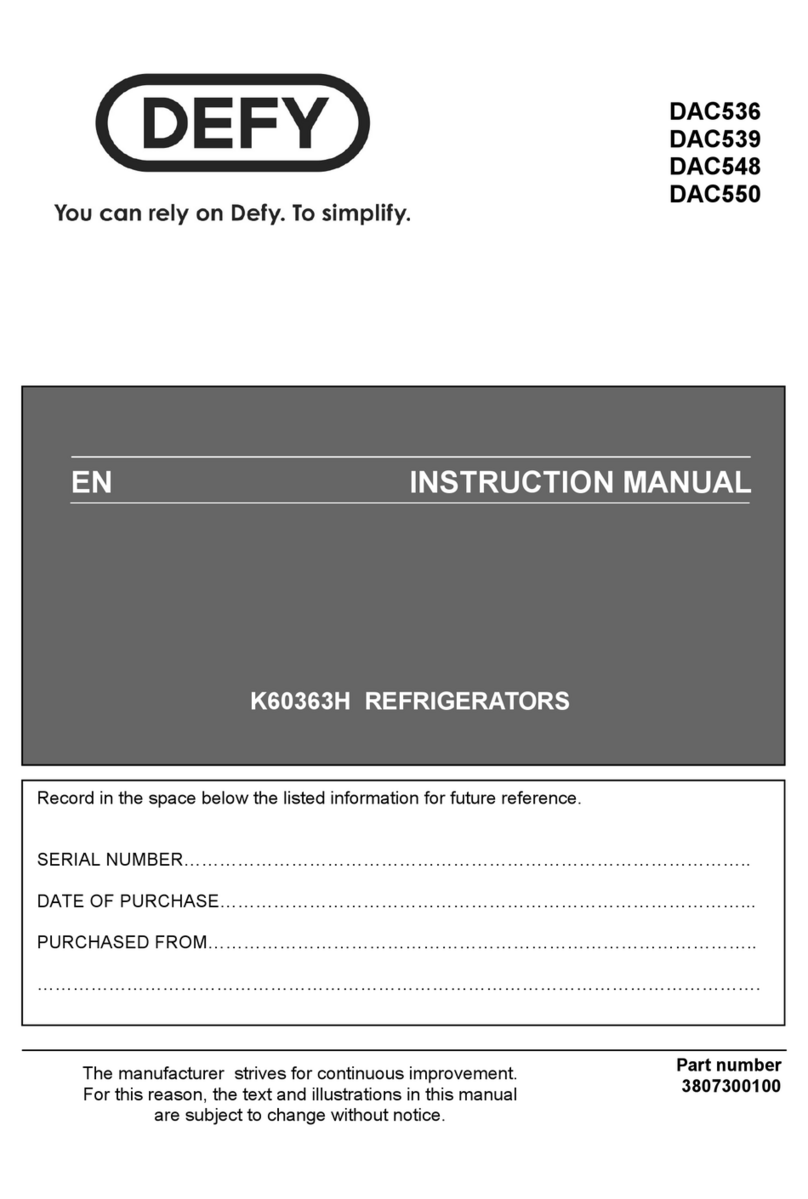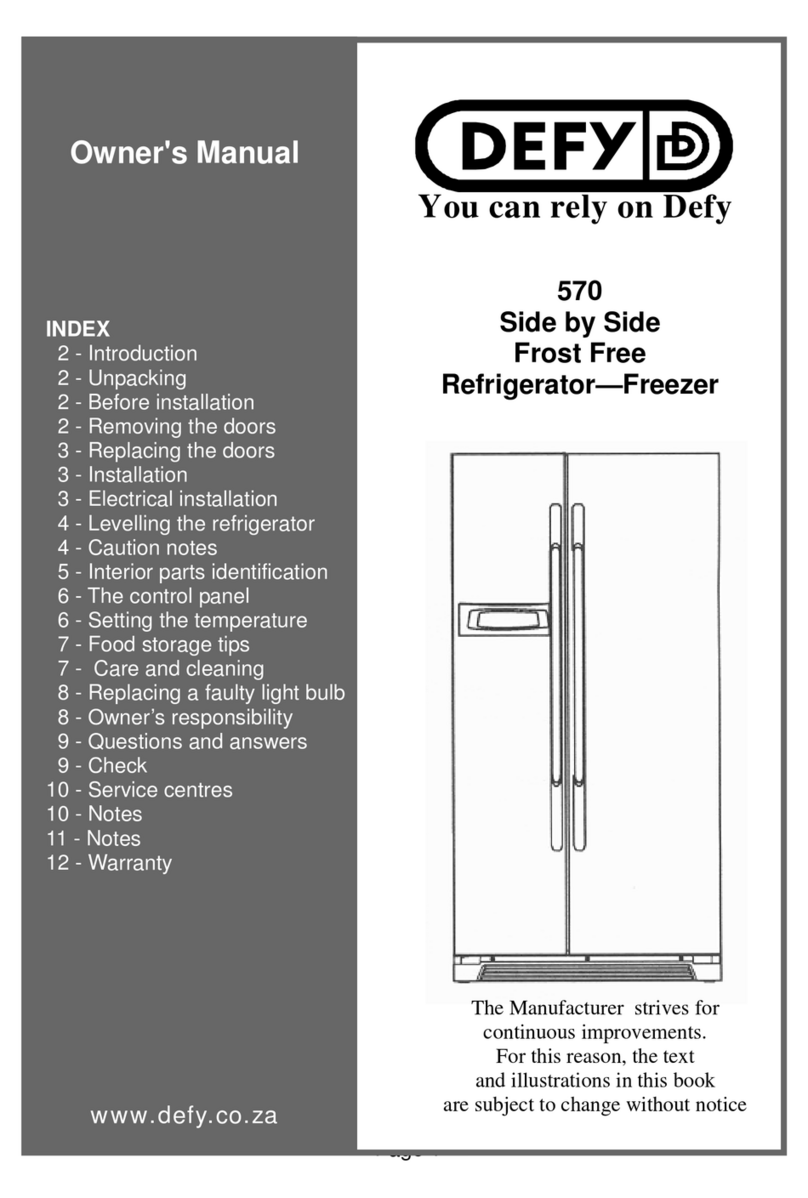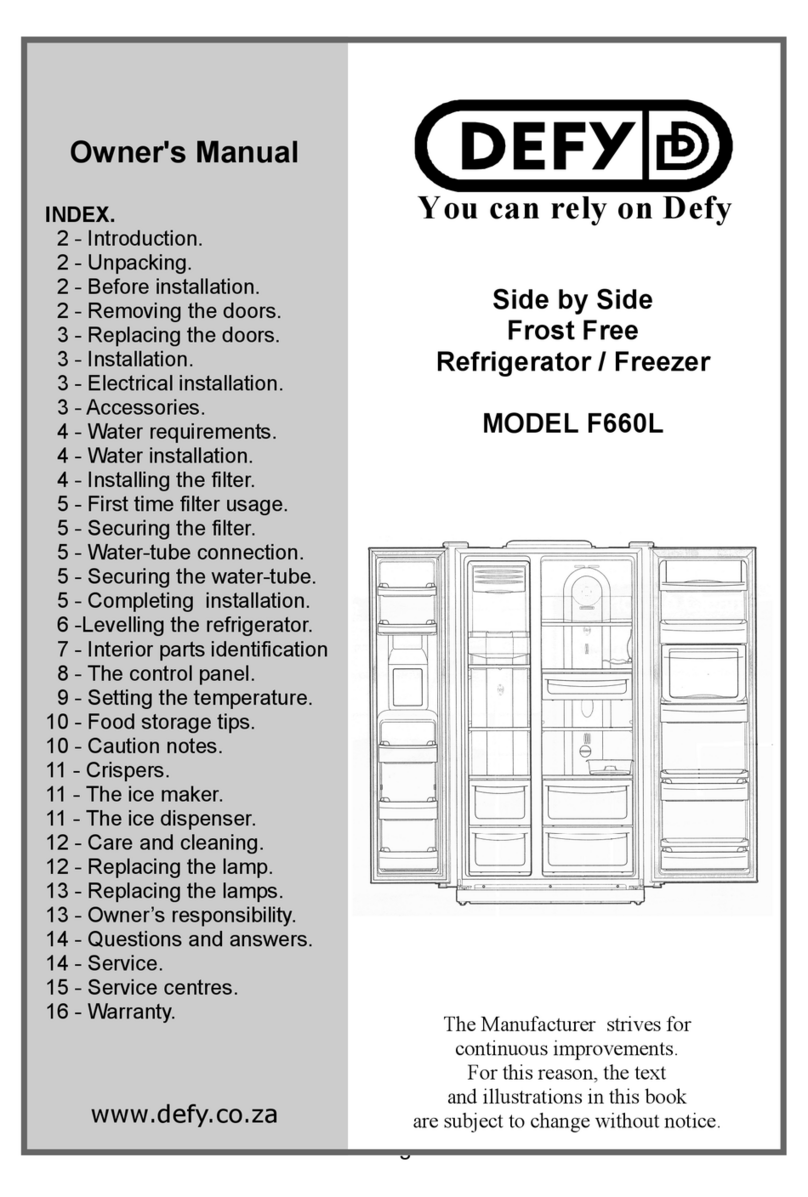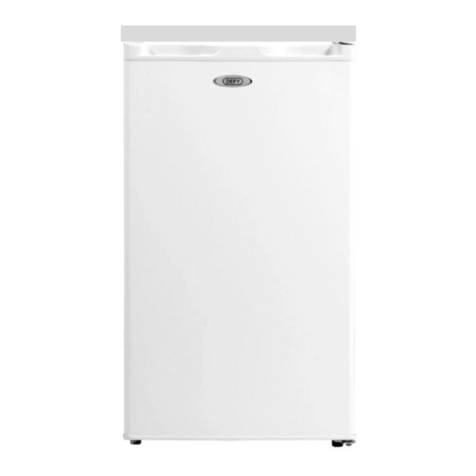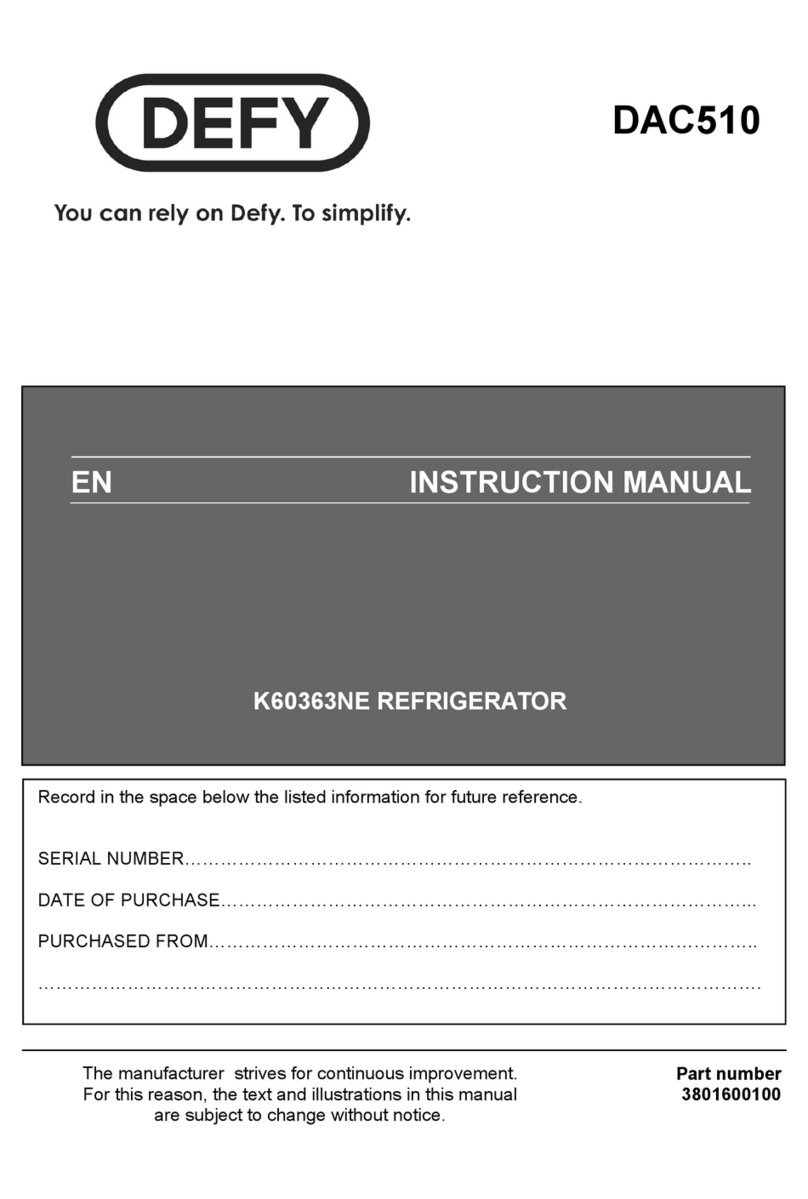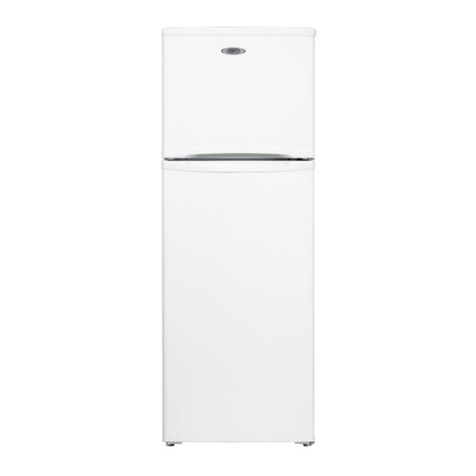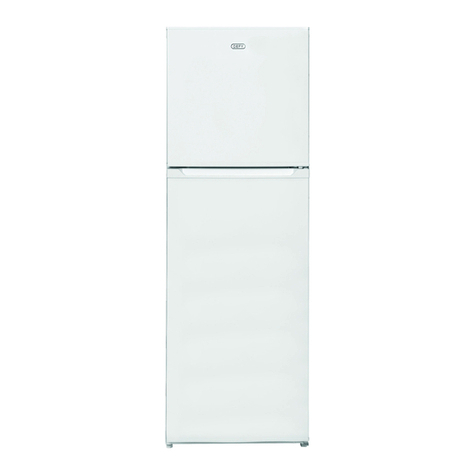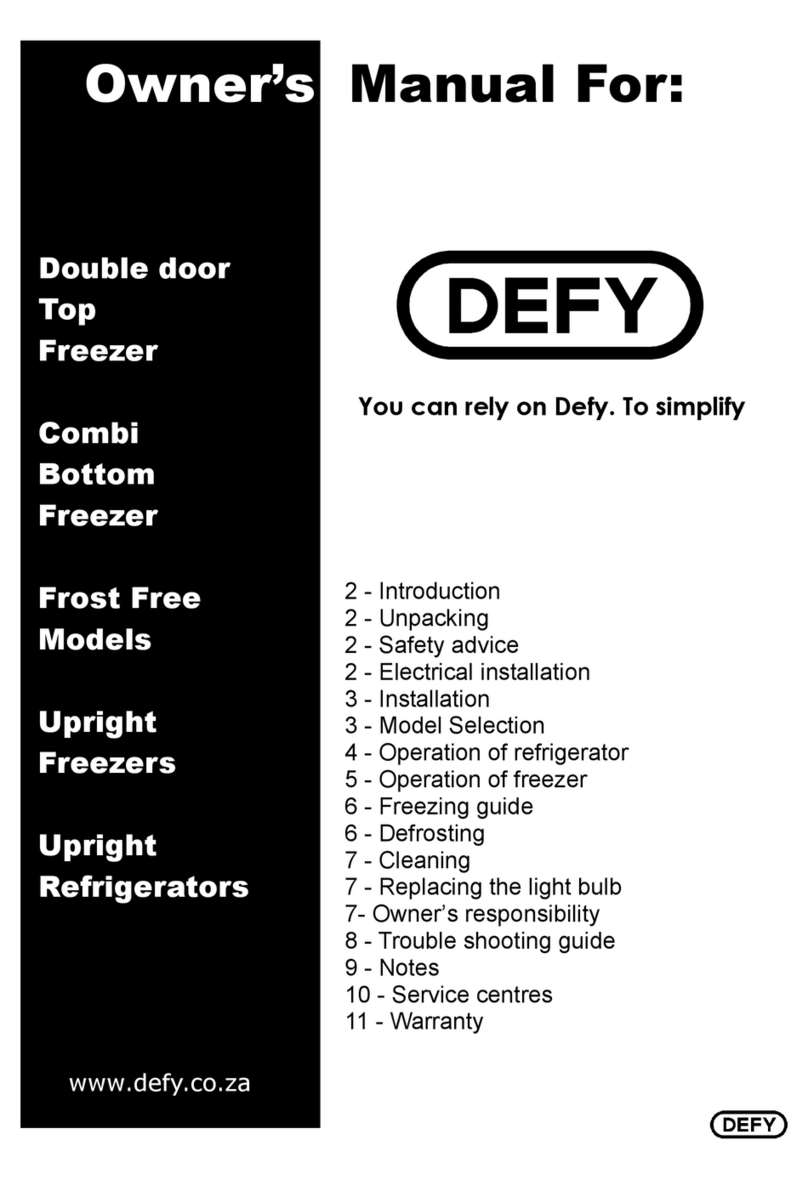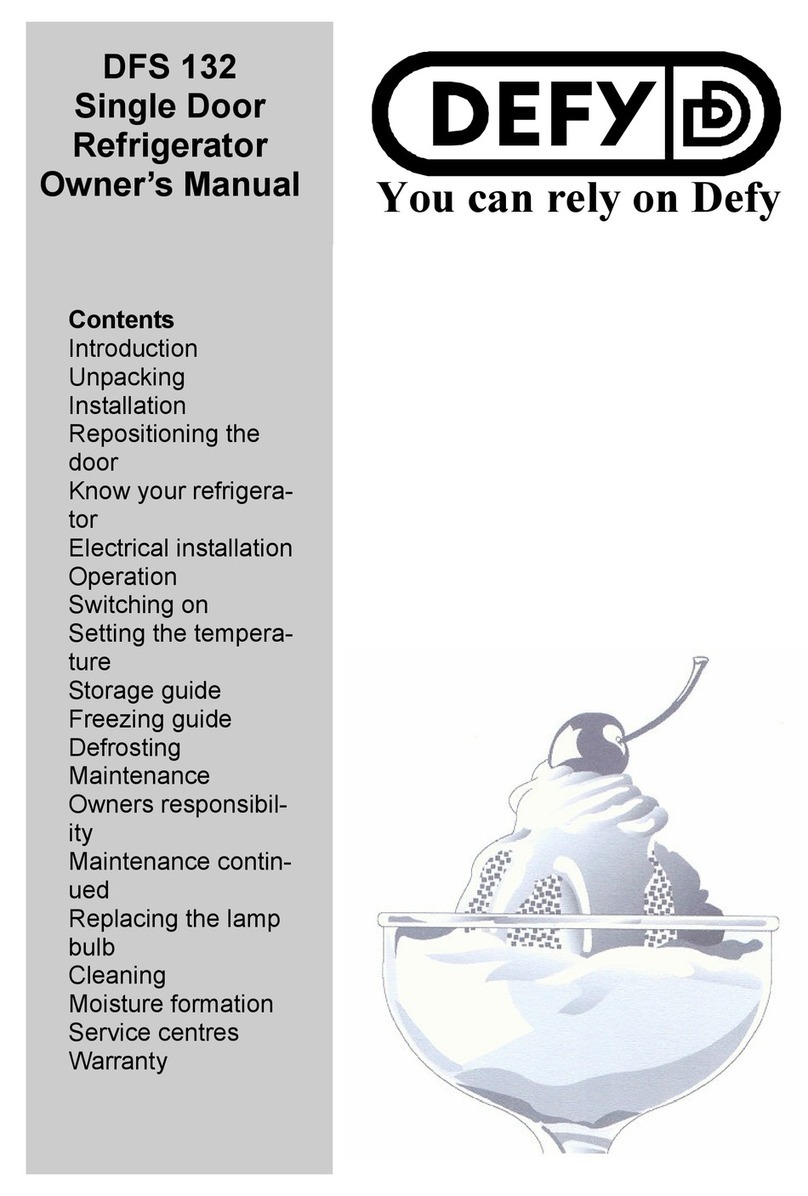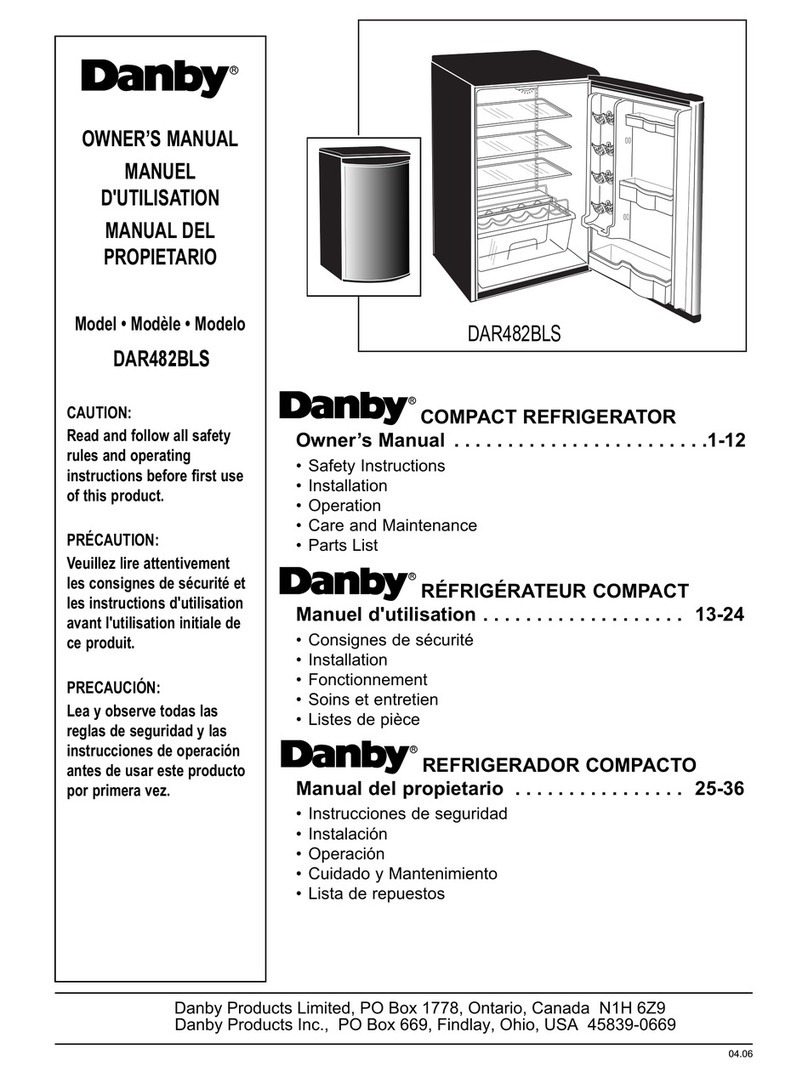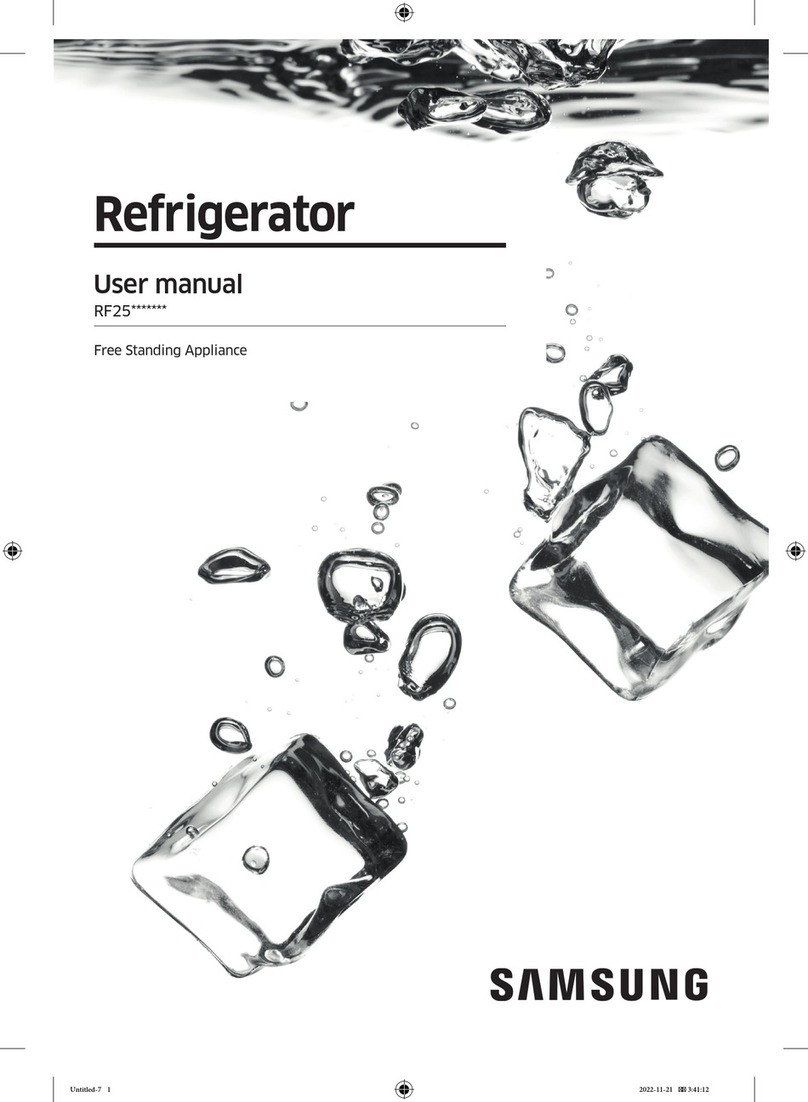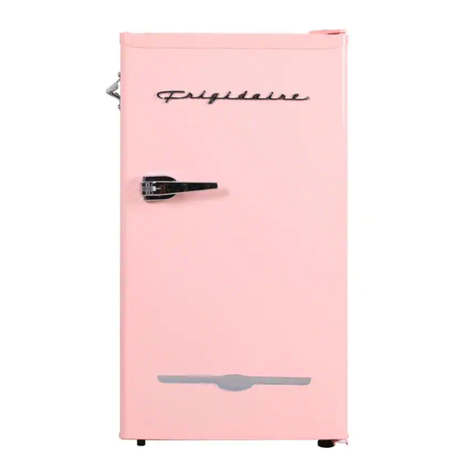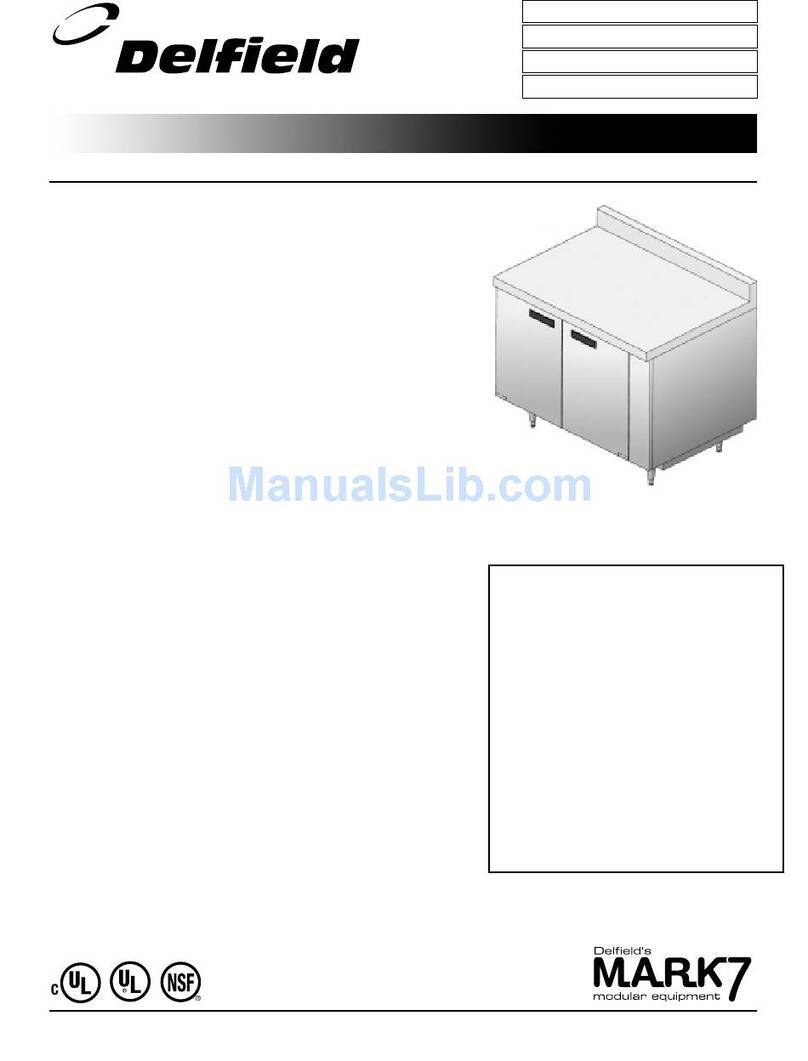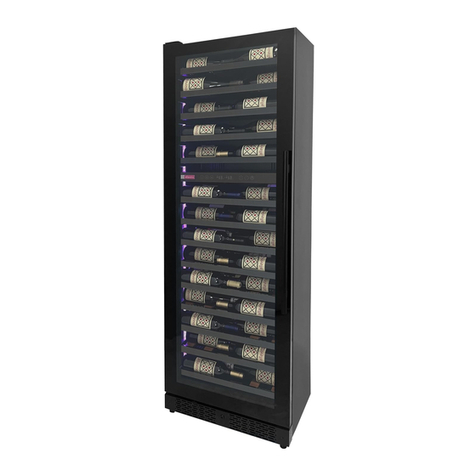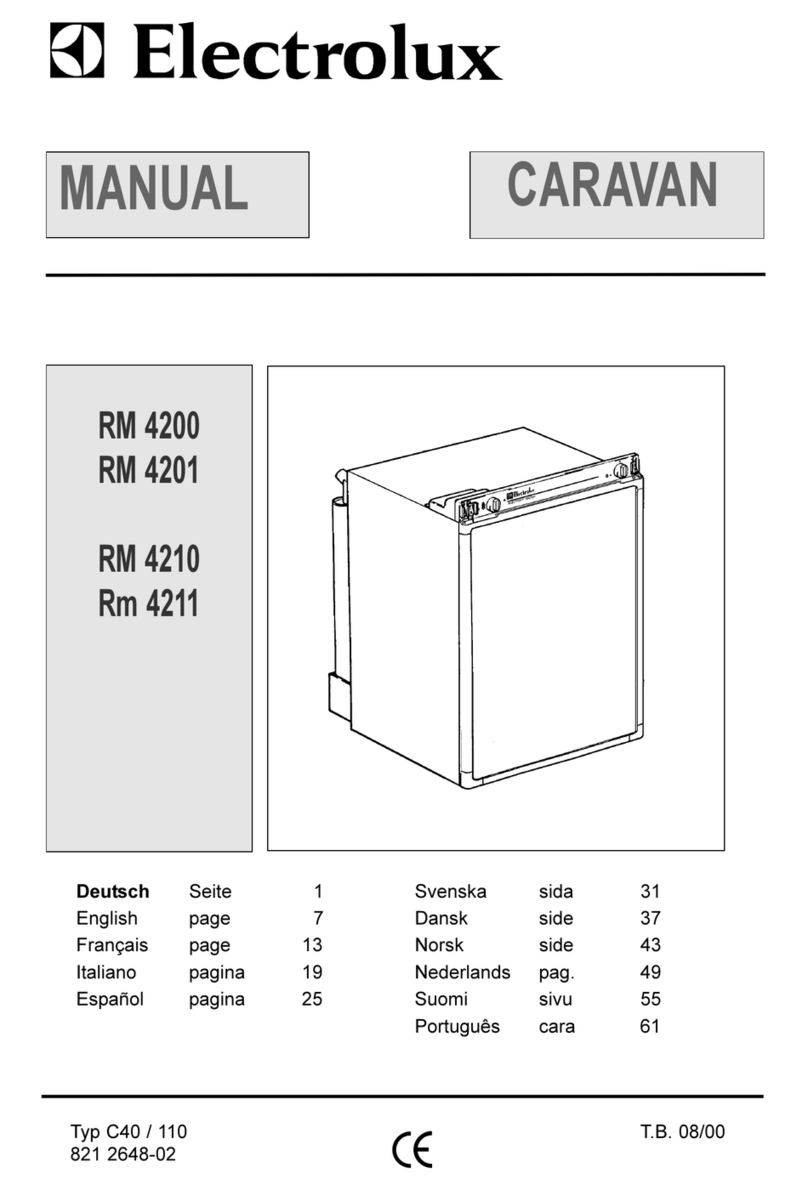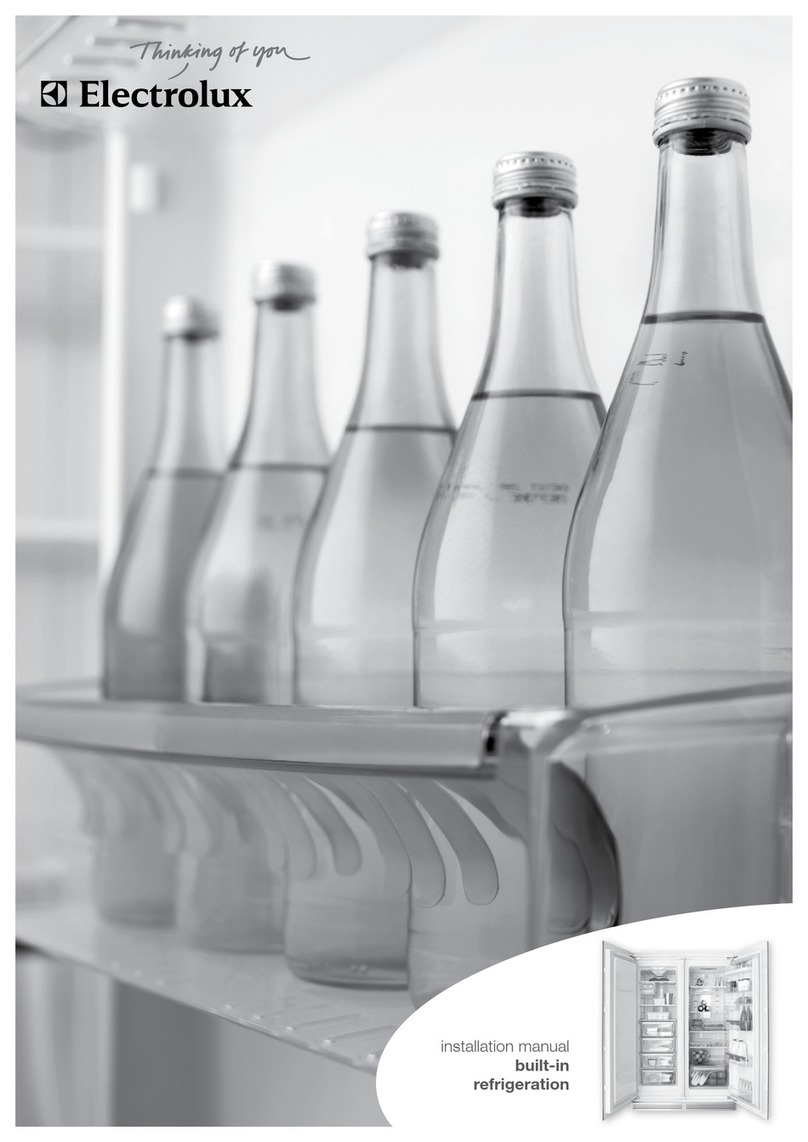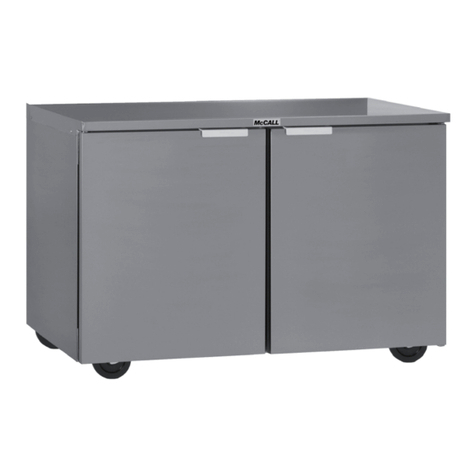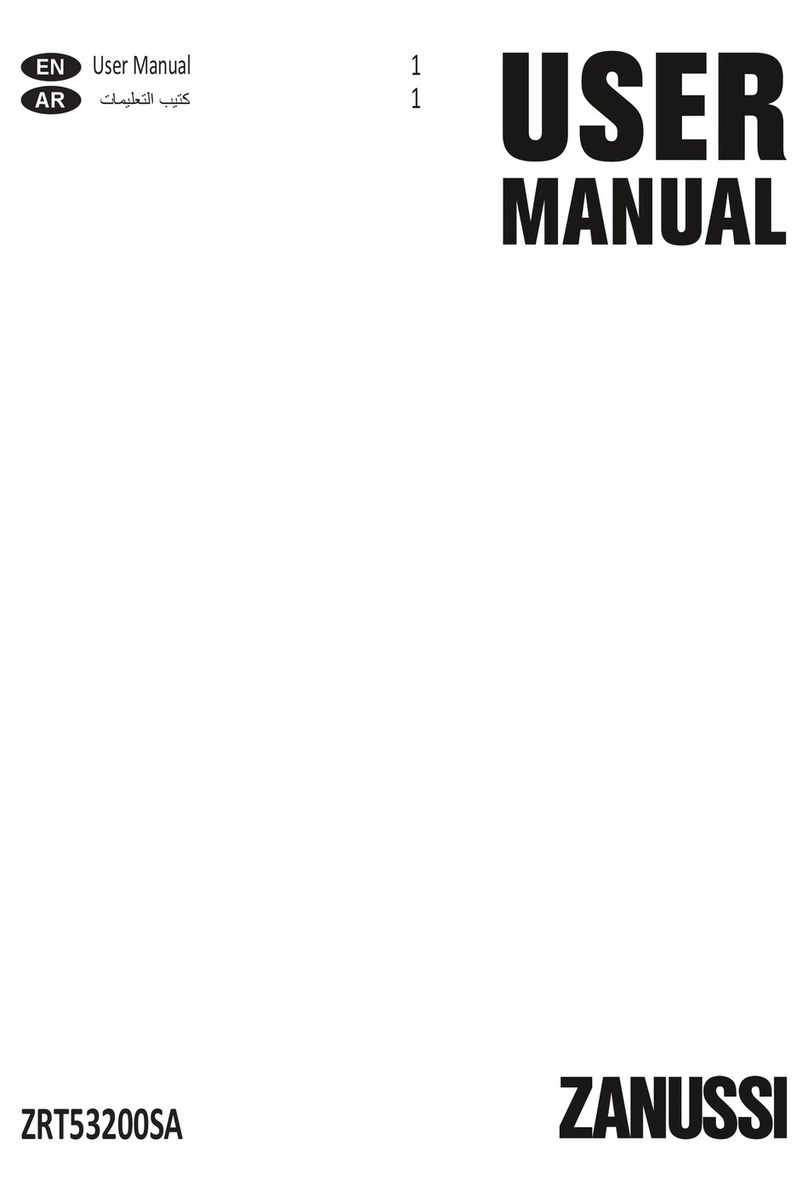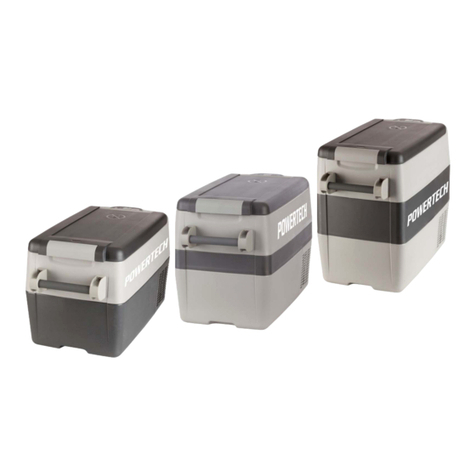Defy KS 60361 W User manual

Page 1
KS 603613 W
KS 60361 W
INSTRUCTION MANUAL
The manufacturer strives for continuous improvement.
For this reason, the text and illustrations in this manual
are subject to change without notice.
Part number
3807300100
EN
K60363H RE RIGERATORS
Record in the space below the listed information for future reference.
SERI L NUMBER..
D TE OF PURCH SE...
PURCH SED FROM..
.

Page 2
Read this manual before initial installation and operation of the
product!
Dear Customer,
Your new Defy refrigerator was manufactured in a state of the art facility and has passed the
strictest quality control procedures.
Please read this manual carefully before using your product for the first time and then store it
within easy reach for future reference.
We trust you will enjoy years of trouble free use.
The user manual:
• This manual will provide you with information on how to safely operate and care for your
product in order that you gain the maximum benefit from it.
• Pay particular attention to any safety instructions.
• Please read all additional documents supplied with your product.
• Please note that this manual may be used for several similar but different models. Please
check for relevance regarding your particular model.
Explanation of symbols used in this manual
Important safety information. Warning for hazardous situations with regard to life and
property.
Caution; Warning for supply voltage.
Caution; Warning for fire hazard.
Caution; Warning for hot surfaces.
Read the instructions.
Useful information. Important information or useful hints about usage.
Unpacking
Remove all packaging.
Ensure that packing material is disposed of in a responsible manner and that any plastic bags
are cut up to prevent children playing with them and accidentally suffocating.
If the refrigerator is damaged in any way do not use it. Report the damage to your dealer who
will take the necessary corrective action.
This refrigerator is not intended for use by persons (including children) with reduced
physical, sensory or mental capabilities or lack of experience and knowledge, unless
they have been given supervision or instruction concerning the use of the
refrigerator by a person responsible for their safety.
Children should be supervised to ensure that they do not play with the refrigerator.

Page 3
Contents
4. Using your refrigerator 12
Temperature control and adjustment 12
5. The freezer compartment 13
Deep Freeze information 13
Deep Freeze packaging information 13
Placing foods 14
6. Water Dispenser 15
Cleaning the water tank 16
7. Maintenance and cleaning 17
8. Trouble Shooting 18
9. Refrigerator specifications 21
10. Service Centres 22
11. Warranty 23
1. Your Refrigerator 4
2. Important Safety Information 5
Warnings 5
Child safety 6
HC Warning 6
Energy saving tips 7
3. Placing and Installation 8
Transportation instructions 8
Before using the refrigerator 8
Electrical connection 8
djusting the feet 9
Reversing the doors 10
Figures in this manual are schematic and may not match your refrigerator exactly.
Values stated on the machine labels or in the documentation accompanying it are
obtained in laboratory conditions in accordance with the relevant standards.
Depending on operational and environmental conditions of the machine, these
values may vary.
Warning: Do not place any copper pots or dishes inside the cabinet.

Page 4
Your Refrigerator
1
The manufacturer strives for continuous improvement. For this reason, technical
specifications, text and illustrations in this manual are subject to change without notice.
Figures represented in this instruction manual are schematic and may not correspond
exactly with your refrigerator. If the parts are not included in the refrigerator you have
purchased, they may be model specific and therefore only valid for some models.
1. Thermostat knob
2. Interior light
3. djustable shelves
4. Bottle rack *
5. Defrost water collection channel
- Drain tube
6. Crisper cover
7. Salad crisper
* (Depends on Model).
8(a). Freezer drawer with ice tray
8. Freezer drawer
9. djustable front feet
10(a). Dairy shelf
10. Door shelf
11. Egg tray
12. Fridge compartment
13. Freezer compartment
14. Water dispenser filling container *
15. Water dispenser upper shelf *
16. Water dispenser tank *
17. Bottle shelf
* (Depends on Model).
8(a)
8
8
10(a)

Page 5
• Unplug the refrigerator when cleaning,
during routine maintenance or if it will not
be used for an extended period.
• To unplug the refrigerator, remove the plug
by pulling on the plug and not the cable!
• Exposing the refrigerator to rain, snow, sun
and wind is an electrical safety risk.
• Should the mains lead of the refrigerator
become damaged or should it need
replacing at any time, it must be replaced
by a special purpose made mains lead
which can only be obtained from a DEFY
uthorised Service gent.
• Never connect your refrigerator to
electricity saving systems as they may
damage the refrigerator.
• Do not store medicine or academic
research samples which require strict
temperature control in the refrigerator.
• Do not store or use flammable gas,
benzene, petrol or volatile substances in or
near the refrigerator.
• Do not store explosive substances such as
aerosol cans with a flammable propellant
in the refrigerator.
• In the event of a malfunction, disconnect
the refrigerator from the power supply.
• Do not overload your refrigerator with
excessive amounts of food. If overloaded,
the food items may fall down and injure
you and damage the refrigerator when you
open the door. Never place objects on top
of the refrigerator, they may fall down and
injure you when you open or close the
refrigerator door.
• If there is a blue light fitted on the
refrigerator, do not look at the blue light
through optics.
Important safety information
Please review and observe the following
information. Failure to do so may result in
injuries or material damage and will render
any warranty and reliability commitments
void. Spare parts for the refrigerator will be
stocked for 10 years to meet any
maintenance or service requirements.
Warnings
• Hand this owners manual over to the new
owner should ownership change.
• The refrigerator must only be used for its
intended purpose, i.e. the storing of edible
foodstuff.
• The refrigerator is intended to be used in
household and similar applications such as
staff kitchen areas in shops, offices and
other working environments; farm houses
and by clients in hotels, motels and other
residential type environments; bed and
breakfast type environments; catering and
similar non-retail applications.
• Consult with your authorised DEFY service
centre for all questions and problems
relating to the refrigerator. Only authorised
agents are to carry out repairs.
• Vapour and vaporized cleaning materials
must never be used in the cleaning and
defrosting the refrigerator. The vapour may
come into contact with the electrical parts
and cause a short circuit or electric shock.
• Do not allow children to hang on the
refrigerator door as the unit could topple
forward risking personal injury. Never use
the parts on your refrigerator, such as the
door, as a means of support or step.
• Do not use electrical appliances inside the
refrigerator or freezer.
• Keep ventilation openings, in the
refrigerator or in the built-in structure, clear
of obstructions.
2
Do not operate a damaged
refrigerator. Consult with your
nearest DEFY service centre
should you have any concerns
The electrical safety of the
refrigerator is only guaranteed if
the earth system of your home is
compliant to national standards.
Never plug the refrigerator into
the wall socket during
installation. Death or serious
injury may result.
Do not drill, cut or modify the
refrigerator. Injuries may result if
the refrigerant circuit is damaged.
See HC warning. Do not
damage the refrigerant circuit.
Repairs must be carried out by
authorised persons only. Repairs
carried out by incompetent
persons create a user risk.

Page 6
• Ensure that there is sufficient spacing
between the refrigerator and surrounding
walls.
• Unplug the refrigerator from the mains
when you clean the refrigerator.
Child safety
• If the door has a lock, the key should be
kept out of reach from children.
• If you are discarding an old refrigerator
with a lock or latch fitted to the door,
disable the lock/latch, and ensure that the
refrigerator is left in a safe condition to
prevent children from being trapped inside
and suffocating.
• Children must be supervised to prevent
them from tampering with the refrigerator.
HCA Warning
Refrigerator cooling systems containing
R600a:
t DEFY, the care and protection of our
environment is an on going commitment.
This DEFY refrigerator is particularly
environmentally friendly and contains non
CFC / HFC natural substances in the cooling
system (Called R600a) and in the insulation
(Called cyclopentane). These are potentially
flammable if exposed to fire. Take care not
to damage, the cooling circuit / pipes of the
refrigerator in transportation and in use.
In case of damage do not expose the
refrigerator to fire or potential ignition
sources and immediately ventilate the
room where the refrigerator is situated.
Ignore this warning if your refrigerators
cooling system contains R134a.
• The refrigerator may move if the
adjustable legs are not properly levelled
on the floor. Levelling the adjustable legs
on the floor helps prevent the refrigerator
from moving.
• When carrying the refrigerator, do not hold
on the door handle as this may cause the
handle to break.
• When placing your refrigerator next to
another refrigerator or freezer, the
distance between the devices should be at
least 80 mm. Failure to do so may cause
adjacent walls to humidify.
• For refrigerators with a freezer
compartment; Do not put bottled and
canned liquid beverages in the freezer
compartment as they may burst.
• Do not touch frozen food with your hands;
they may stick to your hand.
• Never pour or spray water into or on the
refrigerator and do not store liquids, pot
plants or open containers on top of the
refrigerator as these might spill causing
electrical shorting.
• For manually controlled refrigerators, wait
at least 5 minutes before starting the
refrigerator after a power failure.
• void any damage to the power cable
when transporting the refrigerator.
• Bending the cable may cause a fire.
• Never place heavy objects on the power
cable.
• Do not touch the plug with wet hands.
• Do not plug in the refrigerator if the wall
socket is loose.
• On delivery, check to make sure that the
refrigerator is not damaged and that all the
parts and accessories are in perfect
condition.
• Ensure that the plug remains readily
accessible. Do not use multiple adapter
plugs or an extension cable.
Warning: Never dispose of the
Refrigerator in a fire.
Do not dispose of your Refrigerator
along with regular household
waste.
Contact your local authority for
disposal information and facilities
available.
X

Page 7
Energy saving tips
• Ensure your refrigerator is installed in a
well ventilated area. If the ambient
temperature is low (but in no case lower
than 5°C), then the energy saving will be
more. Do not install your refrigerator
under direct sunlight or near heat emitting
appliances such as ovens, dishwashers or
radiators. Keep food in closed containers.
• Ensure the time between buying chilled/
frozen food and placing it in the
refrigerator is kept at a minimum,
particularly in summer. Use a cooler bag
or a special carrier bag to carry frozen
food. Do not put hot food or drinks in the
refrigerator.
• Do not leave the door(s) of the
refrigerator open for long and ensure they
are closed properly after each opening.
• Defrost frozen food in the fridge
compartment, so that frozen food acts as
an ice pack to assist cooling in the fridge.
This will provide energy saving and
preserve the food quality.
• Do not put hot food or drinks in your
refrigerator.
• Do not overload your refrigerator. This
restricts effective air circulation in the
refrigerator.
• Pay attention to keep your food in closed
containers.

Page 8
Transportation instructions
1.The refrigerator must be transported only in
an upright position. The packing must be
intact during transportation.
2. When positioning your refrigerator, take
care not to damage flooring, pipes, wall
coverings etc. Do not move the refrigerator
by pulling the door or handle.
When re-transporting your refrigerator
• Your refrigerator must be emptied and
cleaned prior to any transportation.
• The shelves, accessories, crisper etc.
In your refrigerator must be fastened
securely with adhesive tape to protect
against any jolts.
• Packaging must be tied with thick tape
and strong rope and the transportation
guidelines printed on the package must
be followed.
Your refrigerator should be
installed at least 30 cm away from
heat sources such as hobs,
ovens, central heaters and stoves
and at least 5 cm away from
electrical ovens and should not
be located under direct sunlight.
If two refrigerators are to be
installed side by side, there
should be at least 8 cm distance
between them.
Placing and Installation
3
1. Install your refrigerator in a place that
allows for ease of use.
2. Keep your refrigerator away from heat
sources such as stoves, geysers humid
places and direct sunlight.
3. There must be appropriate air ventilation
around your refrigerator in order to achieve
efficient operation. The refrigerator is to
have at least a 50 mm space from the
ceiling and at least a 50 mm space from
the wall. Fit the Two plastic wall spacers
supplied with the appliance rotating 1/4
turn to the condenser at the back of the
appliance (See Diagram).
4. Place your refrigerator on an even floor
surface to prevent jolts.
5. Do not keep your refrigerator in ambient
temperatures under 10°C.
Please make sure that the interior of your
refrigerator is cleaned thoroughly.
Before using the refrigerator check that:
1. The feet have been adjusted for perfect
levelling.
2. The interior of the refrigerator is clean and
dry.
3. Check the required distance between your
refrigerator and the wall in order to allow
for free air circulation.
4. The plug has been inserted into the wall
socket and the electricity is switched on.
When the door is open the interior light
will come on.
5. You may hear a noise as the compressor
starts up. The liquid and gases sealed
within the refrigeration system may also
give rise to noise, even if the compressor
is not running, this is quite normal.
6. Do not load the refrigerator immediately
after it is switched on. Wait until the
correct storage temperature has been
reached.
Electrical connection
Connect your refrigerator to a grounded
socket which is protected by a fuse with the
appropriate capacity.
Important
The connection must be in compliance with
national regulations.
The power cable plug must be easily
accessible after installation.
The specified voltage must be equal to your
mains voltage.
If the floor is covered with a carpet, your
refrigerator must be elevated 25 mm from
the floor.

Page 9
Adjusting the feet
The refrigerator may move if the adjustable
legs are not properly levelled on the floor.
Levelling the adjustable legs on the floor:
Level your refrigerator by turning the front
legs as shown in the illustration below.
The corner where the legs are is lowered
when the leg is turned in the direction of the
black arrow and raised when turned in the
opposite direction.
Having someone to carefully assist in tilting
the refrigerator slightly will help facilitate this
process.
damaged power cable must be
replaced by a qualified
electrician.
damaged refrigerator must not
be operated before it is repaired!
There is danger of an electric
shock!
Extension cables and multiway
plugs must not be used for
connection.
The front edges of the
refrigerator may feel warm. This
is normal. These areas are
designed to be warm in order to
avoid condensation.
Important!
Care must be taken while
cleaning/carrying the refrigerator
not to touch the bottom of the
condenser metal wires at the
back of the refrigerator, as this
could cause injury.
DEFY declines to accept any
liability should the instructions
not be followed.
When operating your refrigerator for the
first time, please observe the following
instructions during the initial six hours:
• The door should not be opened
frequently.
• The refrigerator must be operated empty
without any food in it.
• Do not unplug your refrigerator.
• Original packaging and foam materials
should be kept for any future
transportation or moving.
Please remember that the manufacturer
shall not be held liable if the information
given in the instruction manual is not
followed.

Page 10
Reversing The Doors
We recommend that you reverse doors (if
required) before switching on for the first
time.
Tools required:
Small and medium size screwdrivers and a
pair of pliers.
Spare Parts supplied in the plastic bag:
The following parts, which are exclusively for
left hand side fitted hinge operation are
supplied in a plastic bag with the appliance:
Upper door top trim hinge covers – there are
2 different parts, one for each side of the top
trim.
Upper door middle hinge bushing / door
stopper assembly.
Keep all the parts supplied in the plastic bag
(and parts which have been removed when
reversing doors) in a safe place for possible
future re-use.
Important: Have somebody to
assist you when moving the
refrigerator and to hold the doors
when removing / re-fitting hinges
and doors to avoid injury and
damage to the product
Please refer to diagrams supplied.
Using the screws and plastic
plugs supplied in the installation
kit inside the fridge, fit handles to
the desired side (see diagram for
locations)
NOTE: Depends on model.
Some models have integrated
handles that are universal to left
and right hand sides and do not
need to be swapped.
Figures represented in this
instruction manual are schematic
and may not correspond exactly
with your refrigerator.
If the parts are not included in the
refrigerator you have purchased,
they may be model specific and
therefore only valid for some
models.

Page 11
Reversing the doors
Proceed in numerical order

Page 12
Using your refrigerator
4
Figures represented in this instruction manual are schematic and may not
correspond exactly with your refrigerator. If the parts are not included in the
refrigerator you have purchased, they may be model specific and therefore only
valid for some models.
Operating temperatures are controlled by the
thermostat knob (see diagram) located on
the cabinet top trim, visible when the
refrigerator door is open.
Settings may be made from 1 to Max, Max
being the coldest position.
When the appliance is switched on for the
first time, the thermostat should be adjusted
so that after 24 hours, the average fridge
temperature is no higher than +5°C.
Set the thermostat half way between the 1
and Max setting and monitor to obtain the
desired temperature i. e. towards Max you
will obtain a colder fridge temperature and
vice versa.
Some sections of the fridge may be cooler or
warmer. (such as the salad crisper and the
top part of the cabinet). This is quite normal.
The normal storage temperature of the
freezer should be -18°C.
Lower temperatures may be obtained by
adjusting the thermostat knob towards the
Max position.
Check the temperature with an accurate
thermometer to ensure that the storage
compartments are kept to the desired
temperature.
Remember to take the reading very quickly
since the thermometer temperature will rise
very rapidly after it has been removed from
the freezer.
Each time the door is opened cold air
escapes and the internal temperature rises.
Therefore never leave the door open and
ensure it is closed immediately after food is
added or removed.
In case of a temporary ice build up in the
fridge compartment, reduce the thermostat
setting to 1, monitoring at the same time that
the fridge temperature is maximum +5°C.
Once the ice build up disappears and the
refrigerator starts auto defrosting again as
normal, then you may increase the
thermostat setting, if required.
Temperature control and adjustment

Page 13
The freezer compartment
Deep-freeze information
• Food must be frozen as rapidly as
possible when placed in a freezer to
maintain its quality.
• It is possible to keep food for a long time
period only at temperatures of -18°C or
lower.
• The quality of food in a freezer can be
maintained for many months at
temperatures of -18°C or lower.
• Pre-packed commercially frozen food
should be stored in accordance with the
frozen food manufacturer’s instructions for
a (4 star) frozen food storage
compartment.
• To ensure that the high quality achieved by
the frozen food manufacturer and the food
retailer is maintained, the following should
be remembered:
Put packages in the freezer as quickly as
possible after purchase. Ensure that
contents are labelled and dated. Do not
exceed “Use By” or “Best Before” dates on
the packaging.
If there is a power failure do not open the
freezer door. Even if the power failure
lasts up to the “Temperature rise time”,
frozen food will not be affected. In case
the failure lasts longer, the food must be
checked and when necessary, must be
consumed immediately or must be frozen
after being cooked.
• Wrap all food before storage. Seal all
foods, or place in airtight containers to
prevent dehydration.
• Eliminate all the air pockets from
packages and keep air out by firm sealing.
• When packaging in sheet material such as
aluminium foil, parcel tightly and press out
all air pockets. ll folds should be sealed
with deep-freeze sealing tape.
• Unwrapped food containing acids or salt
may permanently stain the cabinet interior.
• When loading bulk into the freezer, load
one quarter at a time and allow to freeze
before loading the next quarter.
• Divide food into reasonable portions
according to your requirements.
• llow hot food to cool before putting it into
the freezer. Freeze cooked food in small
quantities. This ensures rapid freezing and
maintains the quality of the food.
• lways use appropriate packaging
material to avoid odour penetration or
degradation of the food.
• Transport pre-frozen food from the
supermarket in foil lined cooler bags and
transfer to the home freezer as soon as
possible.
• Place fresh food to be frozen near the side
walls of the freezer to ensure fast freezing.
• Never exceed the maximum freezing
capacity of the freezer.
• Do not freeze too large a quantity of food
at any one time. The quality of the food is
best preserved when it is frozen right
through to the centre as quickly as
possible.
• Take special care not to mix already
frozen food and fresh food.
Defrosting
The fridge and freezer compartments defrost
automatically.
5
Deep reeze packaging information
• Materials to be used for packaging must
be tear-proof and resistant to cold,
humidity, odour, oils and acids and they
must also be airtight.
• They must be made from materials that
are suitable for deep freeze usage.
Materials necessary for packaging
• Cold resistant adhesive tape, Self
adhesive labels, Rubber rings and a Pen.

Page 14
Do not take out frozen food with
wet hands. Your hands could
stick to the frozen food.
Do not exceed the expiry date
shown on food packs.
Food that has defrosted must be
consumed within 24 hours. Only
cooked food can be refrozen. Do
not re-freeze food that has
defrosted.
Note: If the door of the freezer is
difficult to open just after being
closed, this is due to the pressure
difference which will equalize and
allow for the door to be opened
normally after a few minutes.
Placing foods
Freezer compartment
shelves.
Various frozen food such as meat, fish, ice cream, and
vegetables.
Egg holder. Eggs.
Fridge compartment
shelves.
Food in pans, covered plates and closed containers.
Fridge compartment door
shelves.
Small and packaged food or drinks (such as milk and fruit
juice). Delicatessen products (cheese and butter).
Crisper. Vegetables and fruits.

Page 15
Water Dispenser
The water dispenser is a very useful feature
with regards to accessing chilled water
without having to open the door of your
fridge.
Since you do not have to open the door of
your fridge frequently, you also save on
electricity.
Using the water dispenser
Push in the lever of the water dispenser with
your glass for water flow. Releasing the lever
cuts off the water flow.
When operating the water dispenser,
maximum flow is achieved by fully
depressing the lever.
Please note, how much water flows from the
dispenser depends on how far you depress
the lever. s the level of water in your cup /
glass rises, gently reduce the amount of
pressure on the lever to avoid overflow.
If you depress the lever by a small amount,
then the water will only trickle; this is
perfectly normal and is not a fault .
illing the water dispenser's tank
The water tank filling reservoir is located
inside the door rack. Open the reservoir
cover and fill up with pure and clean drinking
water. Close the cover.
6
Use clean and pure drinking water only.
Capacity of the water tank is 2.0 litres; do
not overfill.
Push the arm of the water dispenser with a
rigid glass. If you are using disposable
plastic glasses, push the arm with your
fingers from behind the glass.
Warning!
Do not fill the water tank with any liquid other
than drinking water; beverages such as fruit
juice, carbonated beverages and alcoholic
drinks are not suitable for use with the water
dispenser.
If such liquids are used, the water dispenser
will malfunction and may be damaged
beyond repair. The warranty does not cover
such usage. Some of the ingredients and
additives in these drinks / beverages may
also attack and damage the water tank
material.

Page 16
Water tray
ny water that drips whilst using the water
dispenser accumulates in the spillage tray.
Remove the plastic strainer by pressing on
the side as shown in the figure. With a clean
and dry cloth, remove the water that has
accumulated.
WARNING: Do not wash any of
the water tank parts in a
dishwashing machine.
Cleaning the water tank
• Remove the water filling reservoir inside
the door rack.
Make sure that the parts and seals removed
(if any) as illustrated in the exploded diagram
below, during cleaning are properly refitted
to prevent any water leakage.
• Remove the water dispenser shelf by
holding from both sides.
• Grab the water dispenser reservoir on
both sides & remove it at an angle of 45°.
• Clean the reservoir by removing its lid.

Page 17
Warning: Repairs must be carried
out by authorised persons only.
Repairs carried out by incompetent
persons create a user risk.
Unplug the refrigerator from the
wall socket when you clean the
refrigerator.
Maintenance and Cleaning
7
1. Always disconnect the plug from the
mains socket before cleaning.
2. Never use any sharp instruments or
abrasive substances, soap, household
cleaner, detergent or wax polish for cleaning.
3. Use luke warm water to clean the cabinet
of the refrigerator and wipe it dry.
4. Use a damp cloth wrung out in a solution
of one teaspoon of bicarbonate of soda to
two litres of water to clean the interior and
wipe it dry with a soft cloth.
5. Make sure that no water enters the
temperature control box or lamp housing and
other electrical items.
6. If the refrigerator is not going to be used
for a long period of time, switch it off and
unplug the power cable, remove all food,
clean it and leave the door ajar.
7. ny dust that gathers on the condenser,
which is located at the back of the
refrigerator, should be removed once a year
with a vacuum cleaner or dusted using a soft
bristle brush.
8. Check door seals regularly to ensure they
are clean and free from food particles.
9. Never:
• Clean the refrigerator with unsuitable
material; e.g. petroleum based products.
• Subject it to high temperatures in any way,
• Scour, rub etc., with abrasive material.
10. lways ensure that the defrost drain,
located below the back wall evaporator in
the refrigerator section, is clean and free
from obstructions.
11. Shelves and freezer baskets may be
removed for cleaning purposes. Replace
baskets in original positions. To remove a
freezer drawer, pull it as far as possible, tilt it
upwards and then pull it out completely.
12. There is no need to defrost semi no frost
models, the freezer defrosts automatically.
For static models see defrosting.
Warning: Do not damage the
refrigerant circuit. Do not use
electrical appliances inside the
food storage compartments of the
refrigerator, unless they have
been recommended by the
manufacturer.
13. To remove the freezer flap door, first
open the door 75 mm then gently pull it off.
Make sure that the flap is in place before
closing the freezer door.
14. void spillage of food particularly small
items like rice, peas, beans through the fan
guard as they may cause the cooling system
to block and therefore operate less
efficiently.
If your refrigerator is not going to be used for
a long period of time, unplug the power
cable, remove all food, clean it and leave the
door ajar.
Spillages, especially citric and acidic juices,
must be wiped up immediately as they could
stain the interior of the refrigerator.
Shelves and freezer baskets, where fitted,
may be removed for cleaning purposes.
Protection of plastic surfaces
Do not place liquid oils or oil-cooked meals in
your refrigerator in unsealed containers as
they may damage the plastic surfaces.
In case of spilling or smearing oil on the
plastic surfaces, clean and rinse the relevant
part of the surface at once with warm water.
Replacing the illumination lamp
To change the lamp used for illumination of
your refrigerator, please call your uthorized
Service.

Page 18
Trouble Shooting
8
Symptom Check
The refrigerator does not
operate.
• Make sure the refrigerator plug is securely plugged in.
• Check for a blown fuse or tripped circuit breaker.
• Test the wall socket for power using another appliance.
• Inspect the electrical cord for damage.
• Eliminate the use of an extension cord, if any is being used.
Condensation on the side
wall of the fridge
compartment.
• Very cold ambient conditions. Frequent opening and closing of
the door. Highly humid ambient conditions. Storage of food
containing liquid in open containers. Leaving the door ajar.
Switching the thermostat to a colder degree.
• Decreasing the amount of time the door is left open or using it
less frequently.
• Covering the food stored in open containers with a suitable
material.
• Wipe the condensation using a dry cloth and check if it persists.
Compressor is not
running.
• The protective thermal relay of the compressor will blow out
during sudden power failures or plug-outs and plug-ins as the
refrigerant pressure in the cooling system of the refrigerator has
not yet been balanced. Your refrigerator will start running
approximately after 15 minutes. Please call a service centre if the
refrigerator does not start up at the end of this period.
• The refrigerator is in defrost cycle. This is normal for an
automatic defrosting refrigerator. The defrosting cycle occurs
periodically.
• Your refrigerator is not plugged into the wall socket. Make sure
that the plug is properly fitted into the wall socket.
• Have the temperature adjustments been correctly made?
• Power might be cut off.
Condensation on the
inner walls of refrigerator.
• Hot and humid weather increases icing and condensation. It is
normal and not a fault.
• Doors might have been left ajar; ensure the doors are fully
closed.
• Doors might have been opened frequently or left ajar for a long
time; open them less frequently.
Food kept in the fridge
compartment drawers are
freezing.
• The fridge temperature might have been adjusted to a very low
temperature. djust the fridge temperature to a warmer degree
and check.
Freezer temperature is
very low while the fridge
temperature is sufficient.
• The freezer temperature is adjusted to a very low temperature.
djust the freezer temperature to a warmer degree and check.
Please review this list before calling a service centre. It could save you time and money. This
list includes frequent complaints that do not arise from defective workmanship or material
usage. Some of the features described here may not apply to your model.

Page 19
Symptom Check
Fridge temperature is
very low while the freezer
temperature is sufficient.
• The fridge temperature might have been adjusted to a very low
temperature. djust the fridge temperature to a warmer degree
and check.
Temperature in the fridge
or freezer is very high.
• The fridge temperature might have been adjusted to a very high
degree. Fridge adjustment has an effect on the temperature of
the freezer. Change the temperature of the fridge or freezer until
the fridge or freezer temperature reaches a sufficient level.
• Doors might have been opened frequently or left ajar for a long
time; open them less frequently.
• Door might have been left ajar; close the door completely.
• Large amount of hot food might have been put in the
refrigerator recently. Wait until the fridge or freezer reaches the
desired temperature.
• The refrigerator might have been plugged in recently. Complete
cooling down of the refrigerator takes time.
The fridge is running
continuously or for a long
time.
• Your new refrigerator may be wider than the previous one. This
is quite normal. Large refrigerators operate for a longer period of
time.
• The ambient room temperature may be high. This is quite
normal.
• The refrigerator might have been plugged in recently or might
have been loaded with food. Cooling down of the refrigerator
completely may last for a couple of hours longer.
• Large amounts of hot food might have been put in the
refrigerator recently. Hot food causes longer running of the
refrigerator until the food has cooled down.
• Doors might have been opened frequently or left ajar for a long
time. The warm air that has entered into the refrigerator causes
the refrigerator to run for longer periods. Open the doors less
frequently.
• The freezer or fridge compartment door might have been left
ajar. Check that the doors are tightly closed.
• The refrigerator is adjusted to a very low temperature. djust
the refrigerator temperature to a warmer degree and wait until
the temperature is achieved.
• The door seal of the fridge or freezer may be soiled, worn out,
broken or not properly seated. Clean or replace the seal.
damaged/broken seal causes the refrigerator to run for a longer
period of time in order to maintain the current temperature.
Humidity occurs on the
outside of the refrigerator
or between the doors.
• There might be humidity in the air; this is quite normal in humid
weather. When the humidity is less, condensation will disappear.
Bad odour inside the
refrigerator.
• The inside of the refrigerator must be cleaned. Clean the inside
of the refrigerator with a sponge, lukewarm water or carbonated
water.
• Some containers or package materials might cause the smell.
Use a different container or different brand of packaging material.

Page 20
Warning: Repairs must be carried
out by authorised persons only.
Repairs carried out by
incompetent persons create a
user risk.
Owner’s responsibility
Do not damage the refrigerant circuit.
Do not use electrical appliances inside the food storage compartments of the appliance,
unless they have been recommended by the manufacturer.
Since the following are not factory faults they are the owners responsibility:
• Damage to the exterior finish.
• Breakage of glass and other components.
• Replacement of light bulbs.
• Damage caused through improper use of the appliance.
• Damage caused by moving the appliance.
Symptom Check
Crispers are stuck. • The food might be touching the ceiling of the drawer. Rearrange
the food in the drawer.
The door is not closing. • Food packages may prevent the door's closing. Repack the
packages that are obstructing the door.
• The refrigerator is not completely level on the floor and rocks
when slightly moved. djust the elevation screws.
• The floor is not level or strong. Make sure that the floor is level
and capable of carrying the weight of the refrigerator.
Noise like wind blowing. • Fans are used to cool the refrigerator. It is normal and not a
fault.
DANGER! lways disconnect the
plug from the wall socket before
any maintenance or cleaning.
This manual suits for next models
1
Table of contents
Other Defy Refrigerator manuals
Popular Refrigerator manuals by other brands
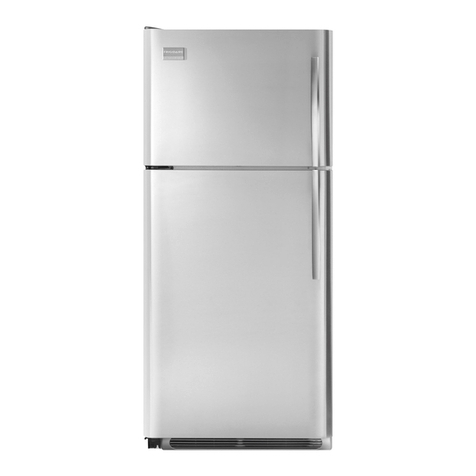
Frigidaire
Frigidaire FPHI2187KR - Professional Top Freezer parts catalog

Hitachi
Hitachi R-Z220ARU7 Service manual
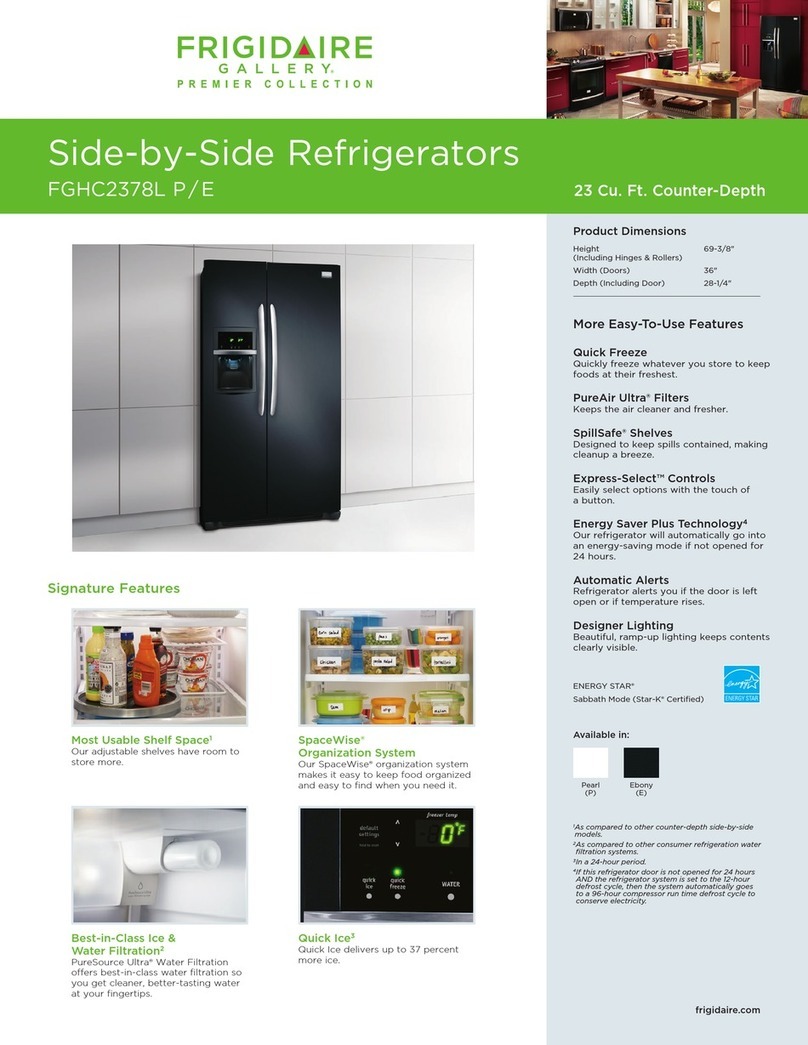
Frigidaire
Frigidaire FGHC2378LE Specification & installation instructions
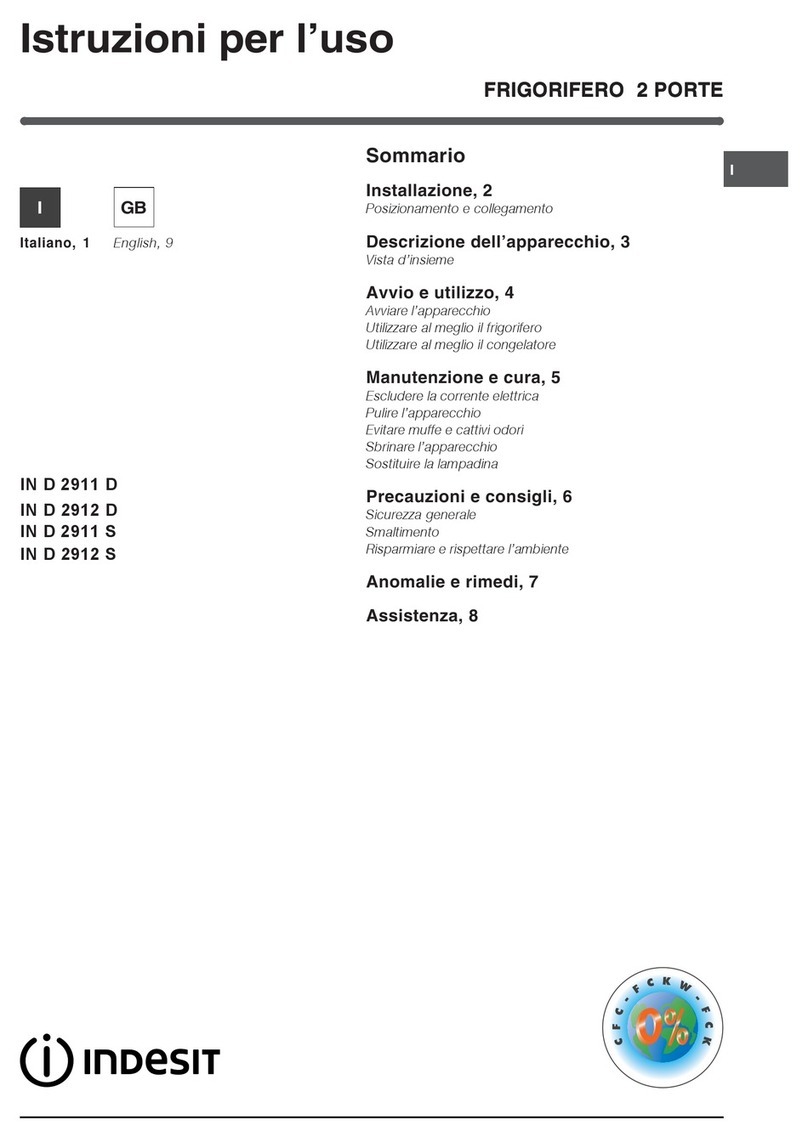
Indesit
Indesit IN D 2911 D operating instructions

KitchenAid
KitchenAid KSSS48QDW05 parts list
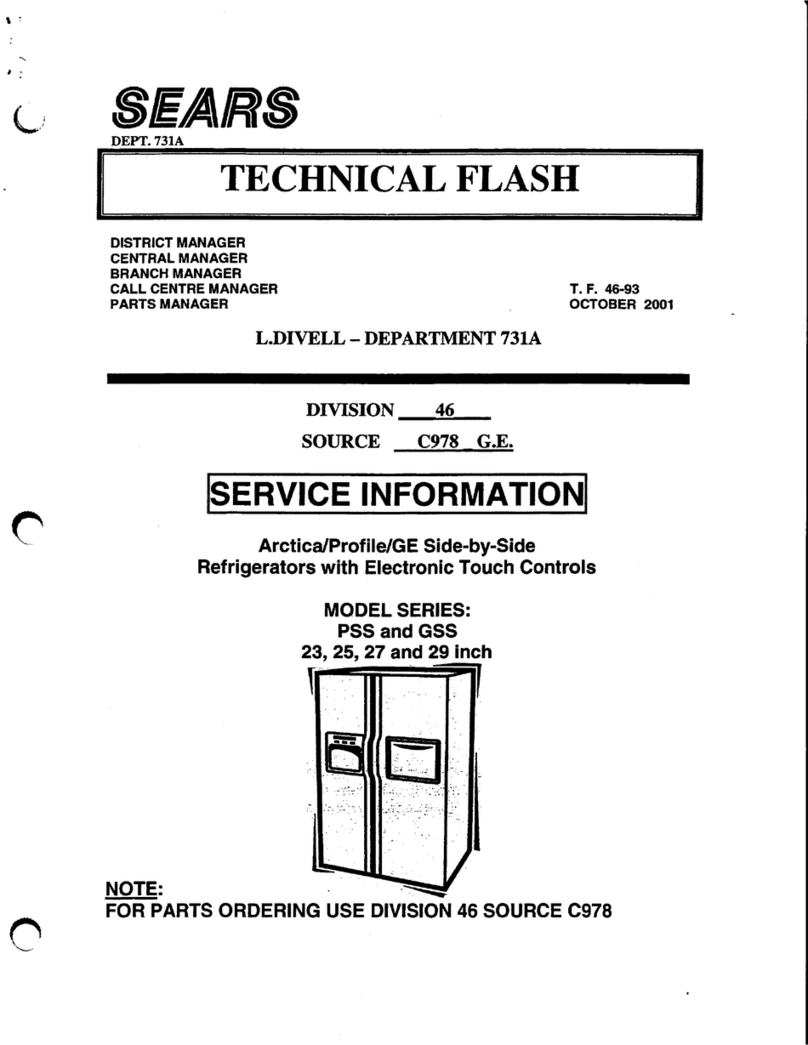
Sears
Sears PSS Series Service information
